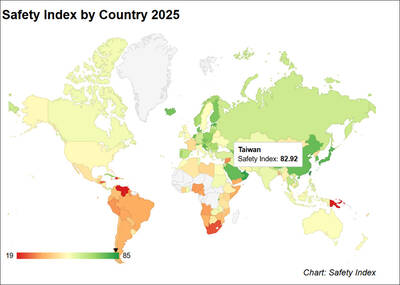The Ministry of National Defense’s smart monitoring system upgrades for important bases are severely behind schedule, the Legislative Yuan’s Budget Center said in its latest report.
The ministry had commissioned the Chungshan Institute of Science and Technology (CSIST) to plan and install a “smart” monitoring system to prevent people from snooping around military bases or impersonating military officials to steal information, the report said.
The system has become necessary because personnel cuts have made it impossible for the patrols to fully cover the bases.

Photo: Reuters
The ministry commissioned the CSIST to build the first batch of smart monitoring systems in 2019, to be used at the military’s Information, Communications and Electronic Force Command, as well as bases with important electronic and communication offices.
In 2020, the ministry said it planned the second phase of the project, which would include essential bases across all three branches of the armed forces, bases for reservists and military police offices.
The project had funding of NT$12.8 billion (US$416.4 million at the current exchange rate), it said, adding that the second round of upgrades were to cover 283 bases and be completed from 2020 to 2025.
Upgrades to 61 bases should have been completed by last year, but the Budget Center said the ministry considered the project to be less than satisfactory from 2019 to 2021, citing a lack of completed system designs and specifications, a failure to complete designs based on military needs, and general issues resulting in delays.
More than half of the 61 sites that should have been upgraded by the end of last year were not completed on schedule, the center said.
The CSIST was also accused of using Chinese-made components during a review last year, resulting in funding for the project being frozen until the ministry provided a report on its investigations.
The most recent ministry report confirmed that the encryption driver for license plate identification and its wireless mice were made in China, adding that it has already swapped out the software.
The license plate identification system is touch-operated, and its function should not be significantly affected by the software change, a separate ministry report said.
The dispatch of personnel, equipment delivery delays and the relaunch of a CSIST equipment bid would further delay the process, it said, adding that it has completed inspections at nine facilities and has yet to inspect 17.
There are 35 facilities that are still installing the system, and the ministry it expects to reach last year’s target by June, it said.

AIR SUPPORT: The Ministry of National Defense thanked the US for the delivery, adding that it was an indicator of the White House’s commitment to the Taiwan Relations Act Deputy Minister of National Defense Po Horng-huei (柏鴻輝) and Representative to the US Alexander Yui on Friday attended a delivery ceremony for the first of Taiwan’s long-awaited 66 F-16C/D Block 70 jets at a Lockheed Martin Corp factory in Greenville, South Carolina. “We are so proud to be the global home of the F-16 and to support Taiwan’s air defense capabilities,” US Representative William Timmons wrote on X, alongside a photograph of Taiwanese and US officials at the event. The F-16C/D Block 70 jets Taiwan ordered have the same capabilities as aircraft that had been upgraded to F-16Vs. The batch of Lockheed Martin

GRIDLOCK: The National Fire Agency’s Special Search and Rescue team is on standby to travel to the countries to help out with the rescue effort A powerful earthquake rocked Myanmar and neighboring Thailand yesterday, killing at least three people in Bangkok and burying dozens when a high-rise building under construction collapsed. Footage shared on social media from Myanmar’s second-largest city showed widespread destruction, raising fears that many were trapped under the rubble or killed. The magnitude 7.7 earthquake, with an epicenter near Mandalay in Myanmar, struck at midday and was followed by a strong magnitude 6.4 aftershock. The extent of death, injury and destruction — especially in Myanmar, which is embroiled in a civil war and where information is tightly controlled at the best of times —

Taiwan was ranked the fourth-safest country in the world with a score of 82.9, trailing only Andorra, the United Arab Emirates and Qatar in Numbeo’s Safety Index by Country report. Taiwan’s score improved by 0.1 points compared with last year’s mid-year report, which had Taiwan fourth with a score of 82.8. However, both scores were lower than in last year’s first review, when Taiwan scored 83.3, and are a long way from when Taiwan was named the second-safest country in the world in 2021, scoring 84.8. Taiwan ranked higher than Singapore in ninth with a score of 77.4 and Japan in 10th with

China's military today said it began joint army, navy and rocket force exercises around Taiwan to "serve as a stern warning and powerful deterrent against Taiwanese independence," calling President William Lai (賴清德) a "parasite." The exercises come after Lai called Beijing a "foreign hostile force" last month. More than 10 Chinese military ships approached close to Taiwan's 24 nautical mile (44.4km) contiguous zone this morning and Taiwan sent its own warships to respond, two senior Taiwanese officials said. Taiwan has not yet detected any live fire by the Chinese military so far, one of the officials said. The drills took place after US Secretary